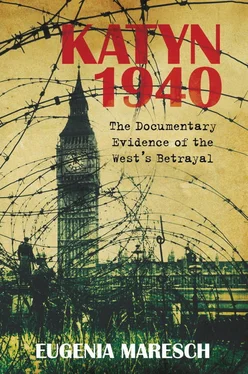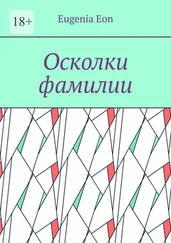One of the most important reports – which clearly indicated the journey and final destination of the last deportation of the Polish officers from Kozelsk – was not amongst Kot’s papers. Although not being able to identify the place as Gnezdovo station, the witness saw the prisoners being unloaded from prisoner’s freight cars at a siding on 30 April 1940 and taken away in groups by a bus with blacked out windows. It would return at intervals to pick up the others and take them to a place he thought must be nearby. This secret observation came from Lt Stanisław Swianiewicz, [19] Stanisław Swianiewicz (1900–1997) Professor of Economics, born in Dyneburg, Latvia, before the Revolution studied at Moscow and Wilno Universities, Head of the East European Institute, expert in the political economy of the Soviets, published Lenin as Economist and Political Economy of Hitler’s Germany . In 1939, Lieutenant 85 Infantry Division, taken prisoner by the Russians, kept at Kozelsk camp till 30 April 1940, taken to Lubyanka and Butyrki prisons, sentenced to eight years hard labour. In 1942 released from GUL ag at the intervention of Ambassador Kot, whom he joined in Kuibyshev. Despatched to the Middle East, to join a Research Bureau in Jerusalem with the task of preparing projects for the expected Peace Congress after the war. Stayed in Great Britain as a political émigré, lectured at the Polish University College in London, then a Fellow in International Studies at the London School of Economics. In 1963 Professor at St Mary’s University, Halifax Canada and Notre Dame University USA. In 1965 Oxford University Press published his outstanding work Forced Labour and Economic Development . In 1989 published his memoirs W cieniu Katynia (In the Shadow of Katyn). Swianiewicz suggests that the meaning of Koze Gory is not Goat’s Hill, but Slanting Hills – Kose gory .
Professor of Economics at Wilno University, who was the only one to be separated from the others at Gnezdovo. He was taken to Smolensk prison and from there eventually to Moscow for a trial and sentence of eight years hard labour in Komi District. Swianiewicz was not aware that he was so close to the place of the massacre. In April 1942, he was released from GULag ( Glavnoe Upravlenie Lagernie ) forced labour camp and eventually reached Kuibyshev to tell the tale. He wrote a short report on 28 May 1942 for Brigadier General Romuald Wolikowski, Military Attaché, which is reproduced below. It still remains a mystery why this vital information did not reach Mason MacFarlane or the Polish government-in-exile any sooner. Was it the fault of an incompetent individual, who failed to register the statement from a civilian witness on the list of officers, or simply forgot to pass the information to the appropriate authorities?
Similarly, Młynarski’s report does not indicate Gnezdovo as a possible place of evacuation for prisoners, but it contained first-hand information on the missing Polish officers and gave precise dates and number of prisoners in each of the three camps who had been mysteriously evacuated to an unknown destination in April and May of 1940. Młynarski asked for help from the British and American governments to impress upon the Russians the need to indicate the whereabouts of these people and to recover them. Historically, Czapski’s concise report, written almost at the same time, tends to overshadow Młynarski’s important document.
Lieutenant Bronisław Młynarski’s Report
Strength of Starobelsk camp
The first batch of prisoners arrived at the camp on 30 IX 1939. About 5,000 other ranks were removed from the camp during October. The winding up of the camp commenced on 5 IV 1940, when the strength amounted to about 3,920, including the sections reserved for Generals and Colonels. This also included over 30 civilians (mostly judges and Government officials) and about 30 officer cadets. The remainder were officers, of whom half were professionals. This included 8 Generals, over 100 Colonels and Lieutenant Colonels, about 230 Majors, about 1,000 Captains, about 2,500 subalterns and about 380 medical officers.
Two other camps, which existed at the same time, were at Kozelsk and Ostashkov. Their strength when wound up on 6 IV 1940 was: Kozelsk about 5,000 men including 4,500 army officers; and Ostashkov about 6,570 men, including 384 Field Police, frontier guards and prison guard officers.
Liquidation of Starobelsk camp
The first group of 195 men were sent from the camp on 5 IV 1940. The Soviet Commandant, Colonel [Aleksandr] Berezhkov and the Commissar [Mikhail] Kirshin, after reading the nominal roll of those to be sent away, declared officially that the camp was to be wound up and its inmates were to be sent to distribution centres from which they were to be repatriated to their domiciles on both sides of the German-Russian frontier. Groups of from 65 to 240 men were sent out daily from the 5th to the 26th of April inclusive, a further group of 200 was sent away on 2 V 1940 and small groups left on the 9th, 11th and 12th May. I left on 12 V 1940 with a group of 16 men. About 10 officers then remained in addition to a few sick officers who were under treatment in the local hospital.
Special groups
After reading a list of about 150 names on 25 IV 1940, the Soviet official declared that he would now read a special roll of 63 names of persons who were to be kept absolutely separate from the rest, during the evacuation of the camp. He repeated this several times, very emphatically. This caused much anxiety in the camp, as no reason for this order was apparent.
Camp at Pavlishchev Bor (near Yukhnov)
After five days of travel, during which we were subjected to the most brutal treatment, the group of 16 to which I belonged arrived at Pavlishchev Bor; the Commandant received us quite well. Here we met the ‘special group’ of 63 men mentioned above. There were thus 79 officers from Starobelsk, including some cadets. If, to this number, we add those officers who were removed from Starobelsk during the first period of our internment there, namely General [Chesław] Jarnuszkiewicz, Colonel [Adam] Koc, Lt Colonel [Jan] Giełgud-Axentowicz, Colonel A[ntoni] Szymanski, Major [Rev.Franciszek] Tyczkowski and Lt W[ładysław] Evert and others it is 85 out of a total number of 3,020, i.e. about 2% of the former strength of these camps.
Griazovets camp (near Vologda)
After about a month the entire camp strength of about 400 was transferred to Griazovets, where they remained from June 1940 until they were liberated. Their living conditions during this period were quite satisfactory. They were joined on 2 VII 1940 by a group of 1,250 officers and other ranks, who had until then been interned in Lithuania, Latvia and Estonia.
Conclusions
Two conclusions may be drawn today, from the results of our investigations and from that fact that no word has reached us from over 8,000 officers and many thousands of other ranks who had been interned in Russia. These are:
1. That the Griazovets camp was the only camp existing in Russia for the Polish PoWs after June 1940 and was probably especially created in order to be able to produce a certain number of representative Polish prisoners of all categories, should the need arise at any time.
2. The declaration that they were returned to German-occupied Poland is completely false as nothing is known of them in that part of Poland. Moreover, about half of the prisoners had their homes in Russian-occupied Poland and no word has been received of their fate either.
Since we cannot believe that the Soviet Government does not intend loyally to fulfil the conditions of its agreement with the Polish Government, we can only think that the non-liberation of these prisoners is due solely to technical and administrative difficulties. Should this be the case, could not the Soviet authorities at least inform us of the whereabouts of these men, in order to permit us with the help of the British and American Governments and people to devise some means of rescuing them?
Читать дальше












